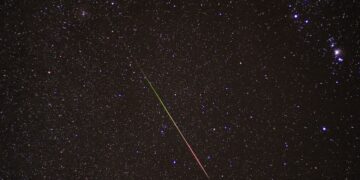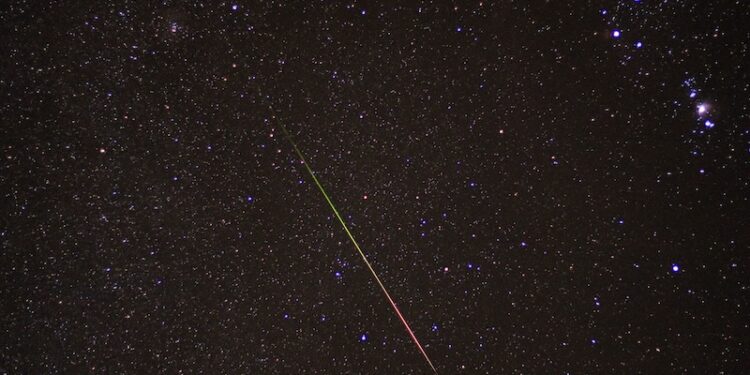The Orionid meteor shower is a celestial event that offers a stunning display of “shooting stars,” as Earth crosses through the debris left behind by the famous Halley’s Comet. Each October, these meteors light up the night sky, creating a mesmerizing spectacle that captures the attention of skywatchers worldwide. This year, the peak of the Orionids falls on the nights of October 22 and 23, promising an exciting opportunity to observe fast-moving meteors racing across the sky, with rates of up to 23 meteors per hour.
What Makes the Orionids Unique?
The Orionids stand out among annual meteor showers due to their direct link to Halley’s Comet, one of the most renowned comets in human history. Halley’s Comet orbits the sun roughly every 76 years, shedding rocky debris that Earth encounters twice a year, resulting in the Orionids in October and the Eta Aquarids in May. Each streak of light is a small fragment of Halley’s legacy, a particle entering Earth’s atmosphere at an astonishing 148,000 mph. This speed contributes to the brilliance of the Orionid meteors, which often leave glowing trails, or “trains,” that linger in the sky for several seconds or even minutes.
These meteors get their name from the Orion constellation, which serves as the radiant point where they appear to originate. However, unlike their namesake suggests, the best way to observe the Orionids is by looking away from Orion. By focusing on areas of the sky about 45 to 90 degrees away from the constellation, viewers can catch more meteors with a wider field of view. This characteristic makes the Orionids accessible to people in both the Northern and Southern Hemispheres, offering a shared experience that connects observers across the globe.
How to Get the Best View of the Orionids
To maximize the chance of seeing the Orionid meteor shower, timing and location are crucial. The optimal viewing window during this peak is between midnight and dawn, when Earth is positioned directly in the path of the debris. During these hours, the darker sky and the direction of Earth’s travel enhance visibility, allowing for more meteors to be spotted. This year, a waning gibbous moon may pose some competition, as its brightness can wash out fainter meteors. However, the brightest meteors, including potential fireballs, should still be visible even with moonlight.
Finding a dark area away from city lights is essential for the best experience. Light pollution can significantly reduce the number of meteors visible, so rural areas or designated dark sky reserves are ideal. Viewers should also allow their eyes about 20 to 30 minutes to adapt to the darkness—this adjustment time enables the eyes to become more sensitive to faint lights, increasing the chances of spotting even the dimmer meteors. Bringing a blanket or reclining chair allows for a more comfortable viewing experience, making it easier to look up and take in the wide expanse of the sky.
The Science Behind Meteor Showers
Meteor showers are a fascinating natural phenomenon, resulting from Earth’s annual passage through streams of debris left by comets or asteroids. When these tiny fragments, often no bigger than grains of sand, collide with Earth’s atmosphere, they burn up due to friction, creating the bright flashes known as meteors. While these particles are small, their high velocity generates enough heat to produce the luminous streaks we call shooting stars. The Orionids, known for their swift speed and occasional fireballs, offer a particularly dramatic display.
Halley’s Comet, the parent body of the Orionid meteor shower, has been a source of wonder since ancient times, appearing in records dating back to 240 BCE. Each time it nears the sun, the comet sheds material, creating streams that trail along its orbit. When Earth intersects these trails, the material ignites as it plunges through the atmosphere, creating the meteor shower we enjoy today. By studying these interactions, scientists gain insights into the composition of comets and the dynamics of our solar system.
The study of meteor showers like the Orionids also helps refine our understanding of the solar system’s evolution. Each shower provides data on the distribution and density of cometary debris, which in turn informs models of how comets break apart and interact with planetary bodies. The Orionids offer a unique opportunity to study these processes, as Halley’s Comet is one of the few comets observed regularly over centuries, providing a well-documented history of its behavior.
Why the Orionids Are Worth Watching
For many skywatchers, the Orionids hold a special place due to their visual appeal and the sense of connection they offer to a famous celestial body. The shower’s meteors, known for their speed and brightness, create a dynamic display that can include long-lasting fireballs—meteors that explode with brilliant light. These moments of intense brightness, combined with the shower’s historic ties to Halley’s Comet, make the Orionids a must-see event for both amateur astronomers and casual stargazers.
Moreover, the Orionids often provide a more intimate viewing experience compared to some other meteor showers like the Perseids, which draw large crowds during the summer months. The cooler October nights, combined with the potential for a quieter, more solitary experience, allow for a more personal connection to the cosmos. It’s a time to reflect on our place in the universe, as ancient particles burn up in our atmosphere, creating a fleeting but unforgettable show.
Halley’s Legacy in the Night Sky
Halley’s Comet may only return to the inner solar system every 76 years, but its influence is felt much more frequently through the Orionids and the Eta Aquarids. The next appearance of Halley’s Comet will be in 2061, making these meteor showers the closest encounter most of us will have with this storied traveler of the cosmos. Each streaking meteor is a reminder of the comet’s passage, a connection to a history of skywatching that spans generations and cultures.
The Orionids and Eta Aquarids are like a time capsule, carrying material from the comet’s distant past to the present day. As these particles burn up, they provide a spectacle that links us to ancient observers who marveled at Halley’s Comet during its previous returns. In this way, the Orionids are not just a meteor shower; they are a bridge to the past and a window into the future of space exploration.
Looking Forward: Future Meteor Showers and Astronomical Events
As the Orionids grace our skies this October, they also signal the beginning of a season filled with other celestial events. Skywatchers can look forward to the Taurid meteor shower in November and the Geminids in December, each offering their own unique displays. These events provide an opportunity to deepen our appreciation for the universe and the dynamic processes that shape our night skies.
The Orionids serve as a reminder of the beauty and mystery that lie beyond our atmosphere. They encourage us to look up, to take a break from the hustle of everyday life, and to connect with the vastness of the cosmos. With each meteor streaking across the sky, we are reminded of the endless wonders that space has to offer, inspiring curiosity and a sense of wonder in all who take the time to watch.
Conclusion: A Cosmic Connection
The Orionid meteor shower offers more than just a light show; it offers a moment to connect with the cosmos and to appreciate the intricate dance of celestial bodies. This year’s peak, despite the challenge of a bright moon, promises a chance to witness the swift and luminous trails that have captivated humans for centuries. As Earth passes through the debris of Halley’s Comet, each meteor serves as a reminder of the comet’s legacy and the mysteries that lie beyond.
Whether you’re an experienced astronomer or simply someone who enjoys the beauty of the night sky, the Orionids provide a special opportunity to witness a piece of the universe in action. So find a dark spot, bundle up, and prepare for a night under the stars. The Orionids are here to remind us of the vastness of space, the beauty of our solar system, and the timeless joy of looking up and wondering what else might be out there, just beyond the reach of our gaze.



















